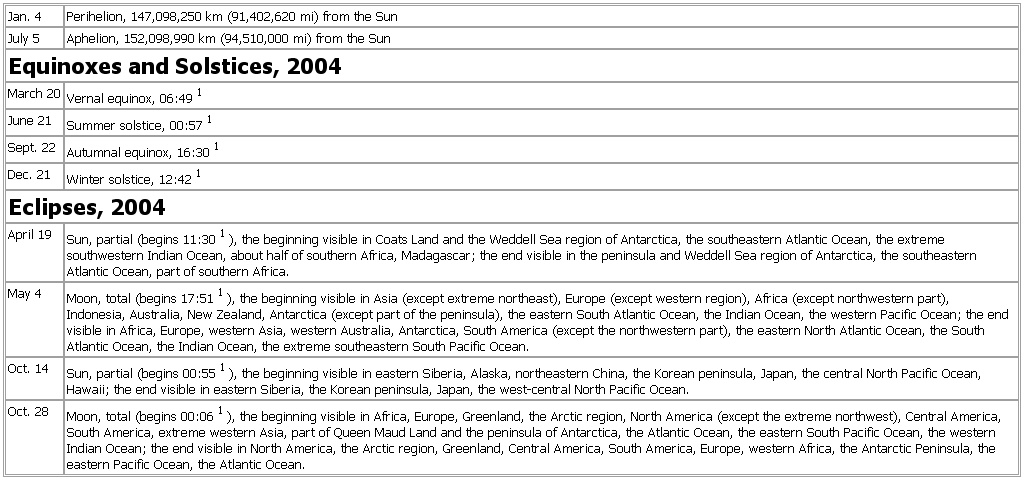- Earth Perihelion and Aphelion, 2004
-
▪ TableJan. 4 Perihelion, 147,098,250 km (91,402,620 mi) from the SunJuly 5 Aphelion, 152,098,990 km (94,510,000 mi) from the SunEquinoxes and Solstices, 2004March 20 Vernal equinox, 06:491June 21 Summer solstice, 00:571Sept. 22 Autumnal equinox, 16:301Dec. 21 Winter solstice, 12:421Eclipses, 2004April 19 Sun, partial (begins 11:301), the beginning visible in Coats Land and the Weddell Sea region of Antarctica, the southeastern Atlantic Ocean, the extreme southwestern Indian Ocean, about half of southern Africa, Madagascar; the end visible in the peninsula and Weddell Sea region of Antarctica, the southeastern Atlantic Ocean, part of southern Africa.May 4 Moon, total (begins 17:511), the beginning visible in Asia (except extreme northeast), Europe (except western region), Africa (except northwestern part), Indonesia, Australia, New Zealand, Antarctica (except part of the peninsula), the eastern South Atlantic Ocean, the Indian Ocean, the western Pacific Ocean; the end visible in Africa, Europe, western Asia, western Australia, Antarctica, South America (except the northwestern part), the eastern North Atlantic Ocean, the South Atlantic Ocean, the Indian Ocean, the extreme southeastern South Pacific Ocean.Oct. 14 Sun, partial (begins 00:551), the beginning visible in eastern Siberia, Alaska, northeastern China, the Korean peninsula, Japan, the central North Pacific Ocean, Hawaii; the end visible in eastern Siberia, the Korean peninsula, Japan, the west-central North Pacific Ocean.Oct. 28 Moon, total (begins 00:061), the beginning visible in Africa, Europe, Greenland, the Arctic region, North America (except the extreme northwest), Central America, South America, extreme western Asia, part of Queen Maud Land and the peninsula of Antarctica, the Atlantic Ocean, the eastern South Pacific Ocean, the western Indian Ocean; the end visible in North America, the Arctic region, Greenland, Central America, South America, Europe, western Africa, the Antarctic Peninsula, the eastern Pacific Ocean, the Atlantic Ocean.See as table:
 1Universal time.Source: The Astronomical Almanac for the Year 2004 (2003).
1Universal time.Source: The Astronomical Almanac for the Year 2004 (2003).* * *
Universalium. 2010.
